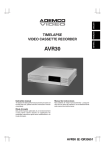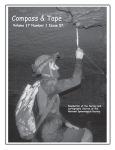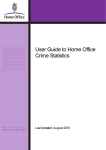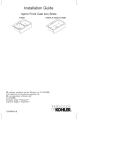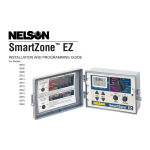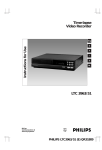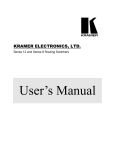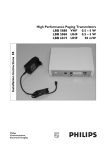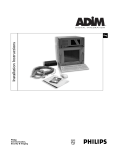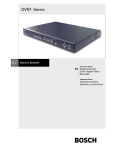Download Philips LTC 3924 VCR User Manual
Transcript
Time-lapse Video Recorder LTC 3924/62 Instructions for Use Eng F E PHILIPS LTC3924/62 (E) QR34071 ENGLISH IMPORTANT SAFEGUARDS 1. Read Instructions — All safety and operating instructions should be read before the unit is operated. 2. Retain Instructions — The safety and operating instructions should be retained for future reference. 17. Damage Requiring Service — Unplug the unit from the outlet and refer servicing to qualified service personnel under the following conditions. a. When the power-supply cord or plug is damaged. 3. Heed Warnings — All warnings on the unit and in the operating instructions should be adhered to. b. If liquid has been spilled, or objects have fallen into the unit. 4. Follow Instructions — All operating and use instructions should be followed. d. If the unit does not operate normally by following the operating instructions. Adjust only those controls that are covered by the operating instructions, as an improper adjustment of other controls may result in damage and will often require extensive work by a qualified technician to restore the unit to its normal operation. 5. Cleaning — Unplug the unit from the outlet before cleaning. Do not use liquid cleaners or aerosol cleaners. Use a damp cloth for cleaning. 6. Attachments — Do not use attachments not recommended by the product manufacturer as they may cause hazards. 7. Water and Moisture — Do not use this unit near water – for example, in a wet basement, in an unprotected outdoor installation, or any area which is classified as a wet location. 8. Accessories — Do not place this unit on an unstable stand, tripod, bracket, or mount. The unit may fall, causing serious injury to a person and serious damage to the unit. Use only with a stand, tripod, bracket, or mount recommended by the manufacturer, or sold with the product. Any mounting of the unit should follow the manufacturer’s instructions, and should use a mounting accessory recommended by the manufacturer. An appliance and cart combination should be moved with care. Quick stops, excessive force, and uneven surfaces may cause the appliance and cart combination to overturn. 9. Ventilation — Openings in the enclosure, if any, are provided for ventilation and to ensure reliable operation of the unit and to protect it from overheating. These openings must not be blocked or covered. This unit should not be placed in a built-in installation unless proper ventilation is provided or the manufacturer’s instructions have been adhered to. 10. Power Sources — This unit should be operated only from the type of power source indicated on the marking label. If you are not sure of the type of power supply you plan to use, consult your appliance dealer or local power company. For units intended to operate from battery power, or other sources, refer to the operating instructions. 11. Grounding or Polarization — This unit may be equipped with a polarized alternating-current line plug (a plug having one blade wider than the other). This plug will fit into the power outlet only one way. This is a safety feature. If you are unable to insert the plug fully into the outlet, try reversing the plug. If the plug should still fail to fit, contact your electrician to replace your obsolete outlet. Do not defeat the safety purpose of the polarized plug. Alternately, this unit may be equipped with a 3-wire groundingtype plug, a plug having a third (grounding) pin. This plug will only fit into a grounding-type power outlet. This is a safety feature. If you are unable to insert the plug into the outlet, contact your electrician to replace your obsolete outlet. Do not defeat the safety purpose of the grounding-type plug. 12. Power-Cord Protection — Power-supply cords should be routed so that they are not likely to be walked on or pinched by items placed upon or against them, paying particular attention to cords and plugs, convenience receptacles, and the point where they exit from the appliance. 13. Power Lines — An outdoor system should not be located in the vicinity of overhead power lines or other electric light or power circuits, or where it can fall into such power lines or circuits. When installing an outdoor system, extreme care should be taken to keep from touching such power lines or circuits as contact with them might be fatal. U.S.A. models only – refer to the National Electrical Code Article 820 regarding installation of CATV systems. 14. Overloading — Do not overload outlets and extension cords as this can result in a risk of fire or electric shock. 15. Object and Liquid Entry — Never push objects of any kind into this unit through openings as they may touch dangerous voltage points or short-out parts that could result in a fire or electric shock. Never spill liquid of any kind on the unit. c. If the unit has been exposed to rain or water. e. If the unit has been dropped or the cabinet has been damaged. f. When the unit exhibits a distinct change in performance – this indicates a need for service. 18. Replacement Parts — When replacement parts are required, be sure the service technician has used replacement parts specified by the manufacturer or that have the same characteristics as the original part. Unauthorized substitutions may result in fire, electric shock or other hazards. 19. Safety Check — Upon completion of any service or repairs to this unit, ask the service technician to perform safety checks to determine that the unit is in proper operating condition. 20. Coax Grounding — If an outside cable system is connected to the unit, be sure the cable system is grounded. U.S.A. models only – Section 810 of the National Electrical Code, ANSI/NFPA No. 701981, provides information with respect to proper grounding of the mount and supporting structure, grounding of the coax to a discharge unit, size of grounding conductors, location of discharge unit, connection to grounding electrodes, and requirements for the grounding electrode. 21. Lightning — For added protection of this unit during a lightning storm, or when it is left unattended and unused for long periods of time, unplug it from the wall outlet and disconnect the cable system. This will prevent damage to the unit due to lightning and power-line surges. FCC & ICES INFORMATION (U.S.A. and Canadian Models Only) WARNING — This equipment has been tested and found to comply with the limits for a Class B digital device, pursuant to Part 15 of the FCC Rules and ICES-003 of Industry Canada. These limits are designed to provide reasonable protection against harmful interference when the equipment is operated in a residential installation. This equipment generates, uses and can radiate radio frequency energy and, if not installed and used in accordance with the instructions, may cause harmful interference to radio communications. However, there is no guarantee that interference will not occur in a particular installation. If this equipment does cause harmful interference to radio or television reception, which can be determined by turning the equipment off and on, the user is encouraged to try to correct the interference by one or more of the following measures: • Reorient or relocate the receiving antenna. • Increase the separation between the equipment and receiver. • Connect the equipment into an outlet on a circuit different from that to which the receiver is connected. • Consult the dealer or an experienced radio/TV technician for help. Intentional or unintentional changes or modifications not expressly approved by the party responsible for compliance shall not be made. Any such changes or modifications could void the user’s authority to operate the equipment. This Class B digital apparatus meets all requirements of the Canadian Interference-Causing Equipment Regulations. The user may find the following booklet prepared by the Federal Communications Commission helpful: “How to Identify and Resolve Radio-TV Interference Problems”. This booklet is available from the U.S. Government Printing Office, Washington, DC 20402, Stock No. 004-000-00345-4. 16. Servicing — Do not attempt to service this unit yourself as opening or removing covers may expose you to dangerous voltage or other hazards. Refer all servicing to qualified service personnel. 1 PHILIPS LTC3924/62 (E) QR34071 SAFETY PRECAUTIONS CAUTION ATTENTION RISK OF ELECTRIC SHOCK DO NOT OPEN RISQUE DE CHOC ELECTRIQUE NE PAS OUVRIR This label may appear on the rear of the unit due to space limitations. The lightning flash with an arrowhead symbol, within an equilateral triangle, is intended to alert the user to the presence of uninsulated “dangerous voltage” within the product’s enclosure that may be of sufficient magnitude to constitute a risk of electric shock to persons. The exclamation point within an equilateral triangle is intended to alert the user to presence of important operating and maintenance (servicing) instructions in the literature accompanying the appliance. CAUTION: TO REDUCE THE RISK OF ELECTRIC SHOCK, DO NOT OPEN COVERS. NO USER SERVICEABLE PARTS INSIDE. REFER SERVICING TO QUALIFIED SERVICE PERSONNEL. WARNING To prevent fire or shock hazard, do not expose units not specifically designed for outdoor use to rain or moisture. Attention: Installation should be performed by qualified service personnel only in accordance with the National Electrical Code or applicable local codes. Power Disconnect: Units with or without ON-OFF switches have power supplied to the unit whenever the power cord is inserted into the power source; however, the unit is operational only when the ON-OFF switch is in the ON position. The power cord is the main power disconnect for all units. External Power Supplies Use Only the Recommended Power Supplies. Power supplies must comply with the requirements of the latest version of IEC 65/VDE 0860. Substitutions may damage the unit or cause a fire or shock hazard. ATTENTION OBSERVE PRECAUTIONS FOR HANDLING ELECTROSTATIC SENSITIVE DEVICES WARNING: Electrostatic-sensitive device. Use proper CMOS/MOSFET handling precautions to avoid electrostatic discharge. NOTE: Grounded wrist straps must be worn and proper ESD safety precautions observed when handling the electrostatic-sensitive printed circuit boards. 1 UNPACKING Unpack carefully. This is electronic equipment and should be handled carefully. Check to ensure that the following items are included: • Model number of unit. If an item appears to have been damaged in shipment, replace it properly in its carton and notify the shipper. If any items are missing, notify your Philips Communication, Security & Imaging Sales Representative or Customer Service. The shipping carton is the safest container in which the unit may be transported. Save it for possible future use. 2 SERVICE If the unit ever needs repair service, the customer should contact the nearest Philips Communication, Security & Imaging Service Center for return authorization and shipping instructions. Service Centers U.S.A. & Canada: 800-326-3270 (717-735-6300) Mexico & Central America: 52-5-564-2726 Europe & Middle East: 011-32-1-440-0711 South America: 54-11-4956-0837 Asia Pacific Region: 011-65-481-4422 For additional information, see www.philipscsi.com. 220-240 V, 50 Hz Power Cords 220-240 V, 50 Hz power cords, input and output, must comply with the latest versions of IEC Publication 227 or IEC Publication 245. 2 PHILIPS LTC3924/62 (E) QR34071 FEATURES CONTENTS Recording • High Density Time-Lapse Video Recorder • Three Touch-Selectable Recording Speeds (08, 24, 40) • Automatic “Alarm-Command” Speed up • Recording Check • On-Screen and On-Tape Time/Date Information • 7-Day Programmable On/Off Timer • “Alarm On” Output • Usable Audio at 08, A24 and A40 hour Speeds IMPORTANT SAFEGUARDS .....................................1 SAFETY PRECAUTIONS............................................2 PRECAUTIONS...........................................................4 CONTROLS AND FUNCTIONS .................................5 INSTALLATION ..........................................................9 EXTERNAL CONNECTIONS....................................10 CASSETTE TAPES ...................................................11 SETUP .......................................................................12 SETTING THE TIME AND DATE..........................13 SETTING [OPTIONS] ITEMS ...............................14 SUMMER TIME FUNCTION ................................14 SETTING THE TIMER ...........................................15 SETTING THE VCR FUNCTIONS ........................17 SETTING THE BUZZER ........................................18 SETTING THE ALARM .........................................19 ALARM MEMORY RECALL AND RESET............20 OPERATION..............................................................21 TAPE RECORDING ...............................................21 REC CHECK ...........................................................21 AUTO REC CHECK ...............................................21 TIMER RECORDING .............................................21 TAPE RECYCLE.....................................................22 ALARM RECORDING ...........................................22 MASTER SYSTEM RESET ...................................22 PLAYBACK ............................................................22 SHARPNESS CONTROL ......................................22 STILL PLAYBACK .................................................23 V.LOCK ADJUST ..................................................23 PLAYBACK IN THE FIELD ADVANCE/REVERSE MODES.........................23 VISUAL SEARCH (High Speed Scan) .................23 ALARM INDEX SEARCH ......................................23 TO SECURE THE VCR ..........................................23 PROBLEM GUIDE.....................................................24 SPECIFICATIONS .....................................................25 MAINTENANCE/INSPECTION SCHEDULES OF MECHANICAL COMPONENTS ................................26 Playback • Time-of-Alarm Memory and Alarm Index Search • High Speed Visual Search • Four Playback Speeds (08, A24, A40, 40) • Still Field, Field-Advance, Field-Reverse and Reverse Playback Security • About 720 hours Memory Protection • Electronic Security Lockout Note: This recorder has a rechargeable battery to maintain display functions and recording mode within 720 hours in the event of power loss. When the recorder is received, the unit must be connected to power source for 48 hours to assure the battery has been adequately charged. Auto Head Cleaning System This system cleans the video heads automatically when a cassette is inserted and ejected or the tape is rewound in the recycle recording mode, to prevent dirt from accumulating on the heads. Touches the video head in the active position Cylinder , , Cleaning roller in the stand-by position (Special material) Tape guide Video head Tape REC CHECK before starting In order to prevent the misrecording, press the PLAY button during recording. See page 21. 3 PHILIPS LTC3924/62 (E) QR34071 PRECAUTIONS Safety • Should any solid object or liquid fall into the cabinet, turn off the unit and have it checked by qualified personnel before operating it any further. • To disconnect the power cord, pull it out by the plug. Never pull the cord itself. Installation • Choose a location in which air can pass through the ventilation holes in the bottom, top and back of the unit to prevent it from overheating. • Do not install the unit near sources such as radiators or air ducts or in a place subject to direct sunlight, excessive dust, mechanical vibrations or shock. • Do not place heavy objects or heat-generating objects on the VCR, or the cabinet could be damaged or the temperature inside the VCR could rise, which could cause a fault. • Never bring a magnet or magnetized object near the VCR because it will adversely affect the performance of the VCR. • Do not install the unit in an inclined position. The unit is designed for operation in a horizontal position. Operation • Condensation If you pour a cold liquid into a glass, water vapor in the air will condense on the surface of glass. This is the condensation of moisture. Condensation on the head drum, one of the most crucial parts of the VCR, will cause damage to the tape. The VCR should not be operated for at least 2 hours after being moved from a cold to a hot environment to avoid condensation from occurring on the head drum. Cleaning • Be careful; when surface of the case is wiped with a volatile agent such as benzine, alcohol, thinner, etc., or a chemically processed cloth, the surface finish may be degraded or its coating may peel off. Repacking • It is wise to save the packing materials and box in case you ever need to ship or store your unit. 4 PHILIPS LTC3924/62 (E) QR34071 CONTROLS AND FUNCTIONS [FRONT] 8 34 5 6 7 1 2 S 9 1011 12 13 14 1516 DISPLAY (See page 7) 1. SLOW TRACKING CONTROL Adjust to optimize the picture quality in the SLOW PLAY mode, e.g. speed 40 hours or field advance/ reverse mode. 2. TRACKING CONTROL Adjust to optimize the picture quality during playback at the 08, A24 and A40 hour speeds. 3. PROG./SHARPNESS CONTROL Press to select one of the six programmable functions. Press to select the picture quality with the UP/HARD or DOWN/SOFT button to hard or soft during playback. See page 22 for SHARPNESS CONTROL. 4. DOWN/SOFT BUTTON Press to decrement, change or reverse to the previous/lower value. Press to adjust the picture quality to soft during playback. 5. START/STOP BUTTON Press to start or stop the programming of a programmable function. (Press once to start the programming sequence and a second time to stop (end) it.) 6. UP/HARD BUTTON Press to increase, change or advance to the next higher value. Press to adjust the picture quality to hard during playback. 7. SET BUTTON 11. REC/PLAY HOURS BUTTONS ▲ (UP): Press to increase hours to the next higher value. ▼ (DOWN): Press to decrease hours to the next lower value. The tape speed will be indicated as part of the monitor display. 12. TIMER BUTTON Press after programming the TIMER for automatic TIMER recording. See page 15 for TIMER programming. 13. V-POS (VERTICAL POSITION) BUTTON/V. LOCK BUTTON Press repeatedly to control the vertical position of the programmable display on the monitor. Press to reduce vertical jitter in the still play mode 14. H-POS (HORIZONTAL POSITION) BUTTON/V. LOCK BUTTON Press repeatedly to control the horizontal position of the programmable display on the monitor. Press to reduce vertical jitter in the still play mode 15. ALARM RESET BUTTON Press to clear POWER LOSS information. When this button is pressed the alarm memory is cleared. 16. ALARM INDEX BUTTON Press this button to cause the INDEX indicator to light, and set the VCR to the visual search mode (press F.FWD or REWIND during playback mode) in this state; the start of the alarm recorded can be located. Press to select the specific value which is to be changed with the UP/DOWN buttons. 8. CASSETTE COMPARTMENT 9. COUNTER RESET BUTTON Press to clear the digital counter to “00000”. 10. RESET BUTTONS Press these buttons at the same time to clear all (microprocessor) functions. Press the “S” button to reset the system. (This does not erase the stored information.) 5 PHILIPS LTC3924/62 (E) QR34071 17 18 19 29 28 27 20 21 22 17. EJECT BUTTON Press to remove the cassette. The EJECT button will not operate in the RECORD mode. 23 24 25 26 25. REWIND/VISUAL SEARCH BUTTON Press to start rewind. Press this button during playback and a reverse playback picture at high speed can be seen. 18. STOP BUTTON Press to stop the tape. The STOP button must be pressed to end the RECORD and PLAY mode. 19. PLAY BUTTON Press to play recorded material in the forward direction. Pressing this during recording makes it possible to check recordings. 26. FAST FORWARD/VISUAL SEARCH BUTTON Press to activate fast forward. Press this button during playback and a forward playback picture at high speed can be seen. 27. FIELD REVERSE BUTTON Press to reverse the tape by one field in the STILL playback mode. 20.TIMER LED The LED lights up during timer recording or timer stand by mode. 28. FIELD ADVANCE BUTTON Press to advance the tape one field in the STILL playback mode. 21. ALARM LED The LED lights up during alarm recording. 22. REC LED The LED lights up during recording. 23. RECORD BUTTON 29. STILL BUTTON Press to momentarily stop tape motion in the play mode. The STILL function allows close inspection of individual scenes. See the description of STILL playback on page 23. Press to start recording. 24. REVERSE PLAY BUTTON Press to play recorded material at the 08 speed in the reverse direction during the PLAY mode. 6 PHILIPS LTC3924/62 (E) QR34071 CONTROLS AND FUNCTIONS (Continued) [DISPLAY] 30 31 32 33 TA B ALARM TAPE END REC 39 INDEX 34 35 36 LOCK A TIMER 40 30. TAPE-IN INDICATOR Lights when a cassette is in the compartment. 37 38 HARD SOFT SPEED HD 41 42 38. SOFT INDICATOR Lights when adjust the picture quality to soft during playback mode and after setting. 31. TAB INDICATOR Lights when a cassette without its safety tab is loaded. 32. ALARM INDICATOR ALARM appears during alarm recording. ALARM flashes when alarm recording ends. 33. TAPE END INDICATOR Lights when the tape reaches the end during recording. Note: “TAPE END” is not displayed when you have selected REWIND, RE-REC in the “RECYCLE FUNCTIONS” menu in the alarm display or you have selected REWIND, STOP IF ALARM but an alarm recording has not bee made. 34. A INDICATOR Lights when no video signal is input. Video signal input will turn this indicator off automatically. 35. TIMER INDICATOR This is lit during timer recording or TIMER stand-by mode. The indicator flashes in the following cases. • A cassette is not loaded. • A cassette without its safety tab is loaded. • The timer has not been programmed. 36. LOCK INDICATOR LOCK appears when the recorder is in the security lock mode. 37. HARD INDICATOR Lights when adjust the picture quality to hard during playback mode and after setting. 39. VCR MODE INDICATORS • • • • • • • REC tt ss tt s t ❙❙ • t❙❙ appears during recording. appears during the rewind mode. appears during the fast forward mode. (or ss) flashes during visual search. appears during the playback mode. appears during the reverse play mode. appears when the STILL button is pressed during play mode and disappears when the STILL or PLAY button is pressed again. (or ❙❙s) appears while the FIELD REV (or FIELD ADV) is held depressed in the still playback mode. Note: Still playback is restored when the FIELD REV (or FIELD ADV) button is released. 40. INDEX INDICATOR INDEX appears when the ALARM INDEX button is pressed. INDEX disappears when the ALARM INDEX button is pressed again. INDEX flashes during alarm indexing. 41. DIGITAL COUNTER Shows the tape counter. The counter does not count during non-recorded sections of a tape. In low temperature, display speed may be slow. The count of a counter is ensured. 42. TAPE SPEED INDICATOR Shows the tape speed. 7 PHILIPS LTC3924/62 (E) QR34071 [REAR] 43 44 45 43. VIDEO IN 46 47 46. AUDIO IN Receives video signal from a video camera or another VCR. Accepts an audio signal from a camera, external sound equipment or another recorder (Line: –8 dBm, 50 kohm, unbalanced). 44. VIDEO OUT For connection to monitor. 45. EXTERNAL INTERFACE (8 X 2-PIN) JACK 47. AUDIO OUT Provides an audio output for a monitor or another recorder (–9 dBm, 600 ohm, unbalanced). Connect an alarm switch, door sensor, etc. 1 2 3 4 5 6 7 8 9 10 11 12 13 14 15 16 q w e r t y u i o !0 !1 !2 !3 !4 !5 !6 ALARM IN ALARM OUT NC TAPE END OUT TAPE END RESET NC NC TIME ADJUST CAMERA SW OUT REC START IN NC NC CONNECTING WIRES 1. Strip off the wire cover by approx. 10mm. 2. Use a screwdriver, etc. to hold the tab, then insert the wire. • Push the tab firmly when inserting wire. 3. Release the screwdriver. • The wire will be fixed. Note: When disconnecting the wire, use the screwdriver again to hold the tab, then pull the wire out. Tab Screwdriver Wire 10mm NC GND GND 8 PHILIPS LTC3924/62 (E) QR34071 INSTALLATION VIDEO CONNECTIONS Use coaxial cables when connecting a camera and a monitor to this VCR. Note: Long cable runs to distant cameras may cause signal deterioration and/or sync discrepancies. If these problems occur, use video line amplifiers and/or cameras having phase-adjustable line-locked vertical sync. Video Input In single camera systems, connect the camera to the Video IN BNC terminal on the VCR rear panel. Use of a 2:1 interlace camera is highly recommended; otherwise, the monitor will show vertical distortion of the TIME/DATE characters. In multiple camera systems, connect the switcher output to the Video IN BNC terminal. Because multiple camera systems require synchronization, use of cameras having line-locked vertical sync or a genlocked master drive/sync source is highly recommended. The use of vertical interval switchers is also recommended. AUDIO CONNECTIONS Audio can be recorded at all speeds. To hear the playback sound, use the 08, A24 or A40 speed during playback. Audio In: Accepts an audio signal from a camera, external sound equipment, or another recorder (Line: –8 dBm, 50 kohm). Audio Out: Provides an audio output for a monitor or another recorder (–9 dBm, 600 ohm, unbalanced). Video Output Connect the monitor to the Video OUT BNC terminal on the rear panel. MICROPHONE PREAMP VIDEO CAMERA/RECORDER MONITOR CAMERA SWITCHER 9 PHILIPS LTC3924/62 (E) QR34071 EXTERNAL CONNECTIONS ALARM IN You can connect an alarm switch with a resistance of 1 kohm or less or a door sensor. Connect pin q to pin !5 or !6 (ground) through the switches. ALARM IN GND q !5 or !6 Note: Do not apply a voltage to pin q, !5 or !6. ALARM OUT Approx. 12V is applied to pin w during an alarm recording. Notes: • When you have selected “PULSE” in the “ALARM OUT” menu in the ALARM display, approx. 12V pulses will be applied to the output after the alarm recording ends. • When you have selected “DURATION” in the “ALARM OUT” menu in the ALARM display, no voltage is applied after the alarm recording ends. • The output impedance is approx. 100 ohm. TAPE END OUT Approx. 12V is applied to pin r when the tape reaches the end. Notes: • This does not operate when you have selected “REWIND, RE-REC” in the “RECYCLE FUNCTIONS” menu in the ALARM display or you have selected “REWIND, STOP IF ALARM” and no alarm recording has been made. • The output impedance is approx. 100 ohm. TAPE END RESET The TAPE END OUT function can be turned off when pin t is shorted to pin !5 or !6. Note: Do not apply a voltage to pin t, !5 or !6. TIME ADJUST When two or more of this VCR model are used, connect via these terminals. With only one VCR, specify TIME ADJUST: MASTER, in [OPTIONS] items on the CLOCK SET display. Specify TIME ADJUST: SLAVE (default setting at the factory) for all other VCRs. Each time “2:00:05A” is reached, the VCR set to MASTER transmits pulses for adjustment to the VCRs set to SLAVE. When the VCRs set to SLAVE receive these pulses, their clocks will adjust to the same time as the clock in the VCR set to MASTER. Note: • Do not connect any device to pin e , y , u , !1 , !2 , !3, !4. • Be sure to set only one VCR to MASTER. If no VCR is set to MASTER, or two or more VCRs are set to MASTER, the TIME ADJUST function will not operate normally. CAMERA SW OUT Pin o outputs the following signal each time a onefield image is recorded. You can combine this with a video camera switcher which can be controlled externally. The output timing can be specified using the SELECTION MENU screen. 4.5~5.5V 0~0.4V 5±2ms REC START IN Recording is started when 5-12V is applied to pin !0. 10 PHILIPS LTC3924/62 (E) QR34071 CASSETTE TAPES It is recommended that you use standard grade VHS video tapes of the following makers: Maxell TDK Fuji TAPE LIFE Slower speed operation in time lapse recording applies stress to video tape. Tapes should be inspected and, if necessary, discarded after the total number of complete tape passes (recording and playback) exceeds the following limits: Tape Speed Complete Tape Passes 08, 24, 40 25 INSERTING A CASSETTE Note: This is the first step in all VCR operations. The VCR will not operate without a cassette in place. To insert a cassette push the cassette through the cassette compartment door until the VCR mechanism pulls it into the compartment. The tape-in indicator turns on. TOP OF CASSETTE (THIS SIDE UP) INSE RT SAFETY TAB SLOT VIDEO CASSETTE SAFETY TAB To prevent accidental erasure of recorded material, remove the safety tab from the lower left corner of the cassette. Recording is impossible when the safety tab is removed. Notes: • The TAB indicator lights when a cassette without its safety tab is loaded. • To record again on a cassette that has its safety tab removed, cover the tab hole with tape. In the TIMER mode, the TIMER indicator will flash on and off if the cassette is inserted without its safety tab slot covered or intact. SAFETY TAB TO PREVENT ACCIDENTAL ERASURE, BREAK OFF THE TAB TO RECORD AGAIN, COVER THE HOLE WITH TAPE Tape Insertion Position Video Cassette Safety Tab REMOVING A CASSETTE Before removing a cassette: rewind the tape completely. To remove a cassette, press the EJECT button. The cassette will come partially out of the compartment so you can pull it out. Important “Avoid using cassette box fabricated out of transparent material.” This is to prevent occurrence of any incorrect operation due to sensor's misdetection. TAPE LENGTH The total recording time at each of the three tape speeds depends on the length of the tape used. The table below shows: 1. The total recording time that can be recorded at each tape speed mode on T120 and T160 tapes. 2. The pictures per second at each speed. 3. The speeds at which audio can also be recorded. Use the table to select the tape length which gives the best compromise between tape cost, total recording time, and elapsed time between pictures. Tape Speed Mode T120 T160 RECORD Pictures/ Second PLAYBACK RECORD Audio PLAYBACK Total Recording Hours 08 6 8 60 60 Yes Yes 24 40 18 30 24 40 20 12 20 12 Yes Yes Yes (A24) Yes (A40) Note: The values in this table are approximate. 11 PHILIPS LTC3924/62 (E) QR34071 SETUP On-Screen displays are provided to aid setup of the programmable functions. The six functions on the Program Menu appear individually on the monitor in this order. 1. CLOCK SET 2. TIMER 3. SELECTION MENU 1 4. SELECTION MENU 2 5. ALARM 6. ALARM MEMORY ❲ C LOCK SET ❳ 01– 01–2002 TUE 12 : 00 : A CLOCK SET ❲ OPT I ONS ❳ OFF OSD TYP E : T I ME ADJ US T : SLAVE TIMER DISPLAY ❲ 1 ❳ 12 : 00A a 12 : 00A 08 ❲ 2 ❳ 12 : 00A a 12 : 00A 08 ❲ 3 ❳ 12 : 00A a 12 : 00A 08 ❲ 4 ❳ 12 : 00A a 12 : 00A 08 ❲ 5 ❳ 12 : 00A a 12 : 00A 08 ❲ 6 ❳ 12 : 00A a 12 : 00A 08 ❲ 7 ❳ 12 : 00A a 12 : 00A 08 MON: ✽ , ✽ TUE : ✽ , ✽ WED : ✽ , ✽ THU : ✽ , ✽ FR I : ✽ , ✽ SAT : ✽ , ✽ SUN: ✽ , ✽ ❲ S ELECT I ON MENU ❳ SE ARCH SP E ED : X5 CAME RA SW : AL L SELECTION MENU 1 SELECTION MENU 2 ALARM DISPLAY ❲ S ELECT I ON MENU ❳ BUZ Z E R SEL E C T I ON TAP E END : OF F TROUBL E : OFF OFF NO V I DE O : AU T O R E C CHECK : OF F A LARM OU T : OF F ❲ A L ARM DURA T I ON : SPE ED : A LARM R E ADY : A LARM OU T : Note: If the VCR is not turned on for about 720 hours after the built-in battery is fully charged (after the VCR is turned on for more than 48 hours), the TIME/DATE display will be cleared. SELECTING A FUNCTION TO BE PROGRAMMED The program menu will always begin with the CLOCK SET function, followed by the TIMER, SELECTION MENU 1, SELECTION MENU 2, ALARM, and then the ALARM MEMORY functions. Although the program menu always follows this order, it is possible to skip any of the available functions during the selection process. To select the desired program function (and to move from one program function to the next), press the PROGRAM button repeatedly until the desired function display format appears on the monitor. After the desired function has been selected, follow the corresponding procedure to set that function. SETTING THE PROGRAM FUNCTION(S) The first step in each programming procedure is: “Press the START/STOP button”. The system allows up to five minutes for any one function setting to be completed after the START/STOP button is pushed. If no change/setting is entered within the five minutes period, the unit will automatically exit the selected program function. (If this happens, reselect the desired program function, and follow the programming procedure for that function.) The following procedures for setting VCR functions assume that the desired function has already been selected. Note: During programming, holding the SET, UP, or DOWN button will move/change the displayed information at a rapid rate. SET ❳ MANUAL 08 YE S DURA T I ON ❲ R ECYCL E FUNC T I ONS ❳ RE W I ND , S TOP I F A LARM ❲ A LARM MEMORY ❳ A00 ALARM MEMORY DISPLAY 1 2 3 4 5 6 7 8 9 Initial Program Function Display Formats 12 PHILIPS LTC3924/62 (E) QR34071 SETUP (Continued) SETTING THE TIME AND DATE Use the CLOCK SET display to set the date and time. TIME (HOUR, MINUTE, SECOND, AM/PM) DATE (MONTH, DAY, YEAR) DAY OF WEEK: Corrected automatically to match the input date. ❲ C LOCK SET ❳ 01– 01–2002 TUE 12 : 00 : A Notes: • Perform the same procedure as when setting the time and date to make corrections after having set them. The minutes flash on/off when the SET button is pressed (in step 2 above). • To record time and date on the tape, display them on the monitor screen. If they are not displayed on the monitor, they cannot be recorded on the tape. ❲ OPT I ONS ❳ OFF OSD TYP E : T I ME ADJ US T : SLAVE TIME ADJUST (MASTER or SLAVE) OSD TYPE (OFF, FULL or HALF) CLOCK SET Display Format Description 1. Press the START/STOP button so that [CLOCK SET] flashes on/off. 2. Press the SET button. The month flashes on/off. 3. Press the UP or DOWN button until the desired number appears on the monitor. 4. Press the SET button. The day flashes on/off. 5. Press the UP or DOWN button until the desired number appears on the monitor. 6. Press the SET button. The year flashes on/off. 7. Press the UP or DOWN button until the desired number appears on the monitor. 8. Press the SET button. The hour flashes on/off. 9. Press the UP or DOWN button until the desired number appears on the monitor. 10. Press the SET button. The minutes flash on/off. 11. Press the UP or DOWN button until the desired number appears on the monitor. 12. Press the START/STOP button: the seconds will start counting and the clock will start. [CLOCK SET] will flash on/off again at this time. 13. To display the time/date you have set here on the monitor screen, press the START/STOP button again to cause [OPTIONS] to flash, and then proceed with step 2 in item on OSD TYPE on page 14. 14. Press the START/STOP button three times. • Make sure that letters [CLOCK SET] or [OPTIONS] are not flashing. 13 PHILIPS LTC3924/62 (E) QR34071 SETTING [OPTIONS] ITEMS OSD TYPE: The TIME/DATE display was not deigned to appear at the factory. If you wish to record the time/date together with image, perform the following procedure: There are two types of TIME/DATE display: FULL and HALF. FULL DATE POWER LOSS (IF SENSED) DAY OF WEEK ALARM COUNT* 12– 20– 2002 6 : 12 : 00P PL 08 FR I A07 T L SECURITY LOCK (IF ACTIVATED) TIMER (IF ON) RECORDING SPEED (IN TOTAL HOURS) TIME * The ALARM Count Number records alarms from 0 to 99 and then resets to 0 and continues counting. HALF DATE No display 12– 20– 2002 6 : 12 : 00P TIME OFF TIME ADJUST: When the two or more of this VCR model are connected to pins i TIME ADJUST of each EXTERNAL INTERFACE jack, the clocks in both VCRs can automatically be set to the same time (TIME ADJUST function). To use the TIME ADJUST function, set one VCR to MASTER and any others to SLAVE. 1. Press the START/STOP button twice so that [OPTIONS] flashes on/off. 2. Press the SET button twice so that the TIME ADJUST: setting flashes on/off. 3. Press the UP or DOWN button to select the setting (SLAVE or MASTER). 4. Press the START/STOP button again. The selected setting will light. Notes: • You can set OSD TYPE and TIME ADJUST after you have set the date and time. • The TIME ADJUST function operates only when the VCRs are turned on. Therefore, turn the VCRs on around 2:00:05A. This function will not operate if the times on the MASTER and SLAVE VCRs drift by more than one hour and 30 minutes. SUMMER TIME FUNCTION Set the summer time function when a cassette is not loaded in this VCR. Press the EJECT and UP buttons simultaneously in modes other than the timer recording standby mode; the hour display will be counted up by one. Press the EJECT and DOWN buttons simultaneously to count the hour display down by one. You can change the hour display in one-hour steps without any limit by pressing the above buttons. Note: Summer time cannot be set unless TIME/ DATE is displayed. No display 1. Press the START/STOP button twice so that [OPTIONS] flashes on/off. 2. Press the SET button so that the OSD TYPE: setting flashes on/off. 3. Press the UP or DOWN button to select the setting (OFF, FULL or HALF). 4. Press the START/STOP button again. The selected setting will light. Note: The position of the TIME/DATE display on the monitor can be adjusted by using the H-POS and V-POS button on the front panel. 14 PHILIPS LTC3924/62 (E) QR34071 SETUP (Continued) SETTING THE TIMER To set the 24 Hour On/Off Timer function. PROGRAM NUMBER TIMER RECORDING TIME START/STOP TIMER RECORDING TAPE SPEED ❲ 1 ❳ 12 : 00A a 12 : 00A 08 ❲ 2 ❳ 12 : 00A a 12 : 00A 08 ❲ 3 ❳ 12 : 00A a 12 : 00A 08 ❲ 4 ❳ 12 : 00A a 12 : 00A 08 ❲ 5 ❳ 12 : 00A a 12 : 00A 08 ❲ 6 ❳ 12 : 00A a 12 : 00A 08 ❲ 7 ❳ 12 : 00A a 12 : 00A 08 MON: ✽ , ✽ TUE : ✽ , ✽ WED : ✽ , ✽ THU : ✽ , ✽ FR I : ✽ , ✽ SAT : ✽ , ✽ SUN: ✽ , ✽ DAY OF WEEK AND PROGRAM NUMBER 1 2 3 4 5 6 7 :TIMER will record for the time set for PROGRAM NUMBER 1 :TIMER will record for the time set for PROGRAM NUMBER 2 :TIMER will record for the time set for PROGRAM NUMBER 3 :TIMER will record for the time set for PROGRAM NUMBER 4 :TIMER will record for the time set for PROGRAM NUMBER 5 :TIMER will record for the time set for PROGRAM NUMBER 6 :TIMER will record for the time set for PROGRAM NUMBER 7 ✽ :No recording TIMER Display Format Description 1. Press the START/STOP button. The program number (1) flashes on/off. 2. Press the SET button. The start hours flash on/off. 3. Press the UP or DOWN button until the desired number appears on the monitor. Remember to watch the AM/PM indicator when setting the hours. 4. Press the SET button. The start minutes flash on/off. 5. Press the UP or DOWN button until the desired number appears on the monitor. 6. Press the SET button. The stop hours flash on/off. 7. Repeat steps 3 through 5 to set the stop hours and minutes. Remember to watch the AM/PM indicator when setting the hours. 8. Press the SET button. The timer recording speed flashes on/off. 9. Press the UP or DOWN button until the desired number appears on the monitor. 10. Press the SET button after setting the timer recording speed. The program number of the next lower line flashes on/off. 11. Repeat steps 2 through 9 to set the program to the other program numbers. 12. Press the SET button after setting the program numbers (1) through (7). The two program event locations of MON flash on/off. 13. Press the SET button. The first program event location of MON flashes. 14. Press the UP or DOWN button until the desired program number appears on the monitor. 15. Press the SET button. The other program event location of MON flashes on/off. 16. Press the UP or DOWN button until the desired program number appears on the monitor. Notes: • If you do not need to timer record two events a day, mark either event with an asterisk (✽). • If two asterisks are displayed, no timer recording is made on that day. 17. After setting two program event locations of MON, press the SET button. The two program event locations of the next day of the week flashes on/off. 18. Press the SET button. The first program event location of the next day flashes. 19. Repeat steps 12 through 16 to set the program event locations up to SUN. 20. Press the START/STOP button when the TIMER has been set. 15 PHILIPS LTC3924/62 (E) QR34071 Notes: 1. Programming the TIMER function does not activate it. See TIMER recording, page 21. 2. To record the time and date press the PROGRAM button to display them. 3. When the preset START time is later than the STOP time, the recording will be made into the following day. 4. When the START time and STOP time are the same, a recording will not be made. 5. When the programs for timer recording overlap each other, recording will be switched to the program with the later recording start time. ,, ,,,,, ,, ,,, ■ To correct information 1. Press the START/STOP button. 2. Press the UP or DOWN button repeatedly until the item to be corrected (Program number or program event location of day of the week) flashes on/off. 3. When the section to be corrected flashes on/off, press the SET button. • Press the SET button again so that only the digit to be corrected flashes on/off. 4. Press the UP or DOWN button to correct the set information. 5. After completing the correction, press the START/STOP button. Example ••••• Record Program number 1 Program number 2 Time Program number 3 When recording of program number 3 is terminated, program number 2 will be recorded for its remaining time. 6. When two programs have the same start time, the program number with the longest stop time has priority. 16 PHILIPS LTC3924/62 (E) QR34071 SETUP (Continued) SETTING THE VCR FUNCTIONS The SELECTION MENU 1 screen allows you to select the VCR operations and functions to match the applications. ❲ S ELECT I ON MENU ❳ SE ARCH SP E ED : X5 CAME RA SW : ALL ~ SEARCH SPEED (3, 5, 7 or 9 times the normal speed) • You can select the visual search speed. CAMERA SW • You can select the timing with which pulses are output to switch the camera. • 24~: The pulses are output during recording at 24 or a longer speed. ALL: The pulses are output during recording in all modes. 08 ONLY: The pulses are output during recording at the 08 speed. SELECTION MENU 1 Format Description 1. Press the START/STOP button. The SEARCH SPEED option “X5” flashes on/ off. 2. Press the SET button repeatedly until the item the setting of which you want to change flashes. 3. Press the UP or DOWN button to select the value or setting you want. 4. After selecting, press the START/STOP button. 17 PHILIPS LTC3924/62 (E) QR34071 SETTING THE BUZZER This VCR has a buzzer function. Use SELECTION MENU 2 to select the times when you wish buzzer to sound. Note: “OFF” is specified for all buzzer options at the factory. TAPE END (ON or OFF) • To specify whether buzzer turns on or off, synchronized with pin r TAPE END OUT of the EXTERNAL INTERFACE jack. ON: Buzzer will keep sounding when tape reaches the end during recording. OFF: Buzzer will not sound even when tape reaches the end. ❲ S ELECT I ON MENU ❳ BUZ Z E R SEL E C T I ON TAP E END : OF F TROUBL E : OFF OFF NO V I DE O : AU T O R E C CHECK : OF F A LARM OU T : OF F TROUBLE (ON or OFF) • To specify whether buzzer turns on or off when abnormality occurs in this VCR. ON: Buzzer will keep sounding if abnormality occurs. OFF: Buzzer will not sound even if abnormality occurs. NO VIDEO (ON or OFF) • To specify whether buzzer turns on or off when no video signal is input during recording. ON: Buzzer will keep sounding when video signal input stops. OFF: Buzzer will not sound even when input stops. AUTO REC CHECK (ON or OFF) • To specify whether buzzer turns on or off if recording is abnormal after the AUTO REC CHECK function. ON: Buzzer will keep sounding if recording is abnormal. OFF: Buzzer will not sound even if recording is abnormal. ALARM OUT (ON or OFF) • To specify whether buzzer turns on or off when alarm is output. ON: Buzzer will keep sounding if alarm is output. OFF: Buzzer will not sound even if alarm is output. SELECTION MENU 2 Format Description 1. Press the START/STOP button. The TAPE END option “OFF” flashes on/off. 2. Press the SET button repeatedly until the item the setting of which you want to change flashes. 3. Press the UP or DOWN button to select the value or setting you want. 4. After selecting, press the START/STOP button. To stop buzzer: 1. When TAPE END lights in the VCR display, press the EJECT button: The tape will come out and the buzzer will stop. 2. When “A” lights in the VCR display and also “NO VIDEO” appears on the monitor screen, the buzzer will stop when video signal is input. 3. When “REC CHECK” appears on the monitor screen, press the STOP button: The buzzer will stop. 4. When alarm indicator ALARM flashes in the VCR display, press the ALARM RESET button: The buzzer will stop. 5. If buzzer function varies in any of the above cases, the VCR may be abnormal. Press the RESET buttons simultaneously: The buzzer will stop. However, note carefully that all settings will return to initial values set at the factory. Note: You can also stop buzzer by switching ON to OFF in SELECTION MENU 2. 18 PHILIPS LTC3924/62 (E) QR34071 SETUP (Continued) SETTING THE ALARM The ALARM function allows the user to set the recording duration, speed to be recorded and tape recycle for alarm recordings. When a contact closure occurs at the ALARM IN input, the VCR automatically enters the RECORD mode at the pre-programmed ALARM recording speed. (See Alarm In, page 10 for a complete description of the ALARM sequence.) The ALARM recording duration can last according to the set value, or until the contact closure is reopened. The ALARM recording speed can be pre-programmed to 08, 24 or 40. The checking signal is automatically recorded on the tape at the beginning of each ALARM recording. Later, you can easily locate the start of each recording by using these signals when watching a recorded content. See “ALARM INDEX SEARCH” on page 23 for details. See page 14 if you also want to record the date/time. The TIME/DATE display is set as follows during ALARM display. — ALARM stars (✽) will replace the colons (:). — The recording speed will be changed to 08, 24 or 40 which was selected from the “SPEED” setting in the ALARM display. DURATION: User programmable length or time the unit stays in the alarm record mode. (MANUAL, 5 SEC, 15 SEC, 30 SEC, 1 MIN, 3 MIN, 5 MIN, 10 MIN, 30 MIN, 60 MIN or TAPE END.) ALARM RECORDING TAPE SPEED (08, 24 or 40) ALARM READY (YES or NO) ❲ A L ARM DURA T I ON : SPE ED : A LARM R E ADY : A LARM OU T : SET ❳ MANUAL 08 YE S DURA T I ON ❲ R ECYCL E FUNC T I ONS ❳ RE W I ND , S TOP I F A LARM Notes: • When the ALARM recording ends, the VCR will return to the status it was in before the alarm was input. • Select 08 at the “SPEED” setting when the alarm input is within 30 seconds. If the 24 or 40 speed is selected, electronic “marks” are not recorded on the tape and alarm index search will not operate. 1. Press the START/STOP button. The duration setting flashes on/off. 2. Press the UP or DOWN button until the desired setting appears on the monitor. (MANUAL, 5, 15, 30 SEC, 1, 3, 5, 10, 30, 60 MIN, TAPE END) 3. Press the SET button. The record speed setting flashes on/off. 4. Press the UP or DOWN button until the desired setting appears on the monitor. (08, 24 or 40) 5. Press the SET button. The alarm ready setting flashes on/off. 6. Press the UP or DOWN button to select the alarm ready function. (YES or NO) Select “YES” if you want to start alarm recording even in the normal record or stop mode. Select “NO” if you do not want alarm recording in the stop mode. 7. Press the SET button. The alarm out setting flashes on/off. 8. Press the UP or DOWN button to select the alarm out function. See “ALARM OUT” on page 10 for details. (DURATION or PULSE) 9. Press the SET button. The RECYCLE position flashes on/off. 10. Press the UP or DOWN button to select the mode at the end of tape. See “TAPE RECYCLE” on page 22 for details. 11. Press the START/STOP button. Programming for the ALARM has been completed. ALARM OUT (DURATION or PULSE) RECYCLE FUNCTIONS (“REWIND, STOP IF ALARM”, “REWIND, STOP” or “REWIND, RE-REC”) ALARM Display Format Description 19 PHILIPS LTC3924/62 (E) QR34071 ALARM MEMORY RECALL AND RESET The VCR signals that an alarm has occurred by flashing the ALARM indicator. If a power loss has occurred, “PL” will appear in the first line of the FULL type TIME/DATE display. ALARM COUNT : Displays the number of alarm inputs that have occurred. Counts up to 99 inputs. ❲ A LARM MEMORY ❳ A00 1 2 3 4 5 6 7 8 9 ALARM MEMORY: 1: Displays the date/time of the first alarm recording. 2~9: Displays the 8 dates/times of the last alarms to have occurred including the last alarm recording. ALARM MEMORY Display Format Description To recall the ALARM display: 1. Press the PROGRAM button until the ALARM MEMORY display appears on the monitor. 2. Log the time/date information from the ALARM memory. To reset the ALARM memory: • When the ALARM RESET button is pressed once, if “PL” is flashing, “PL” will disappear. Press the button again to clear the ALARM memory. • When “PL” is not flashing, press the ALARM RESET button once to clear the ALARM memory. 20 PHILIPS LTC3924/62 (E) QR34071 OPERATION TAPE RECORDING CAUTION: Recording over existing recorded material will completely erase that material. To prevent accidental recording over the end of a previous recording, advance the tape several seconds before beginning the next recording. 1. Insert a video cassette; be sure the cassette safety tab is intact, or the tab slot is covered. 2. Press the REC/PLAY HOURS button until the desired tape speed is observed on the tape speed indicator. 3. Press the RECORD button to start recording. 4. Press the STOP button to stop recording. Notes: — The tape speed mode can be changed during recording. — AUDIO can be recorded at the 08, 24 or 40 tape speed. — “NO VIDEO” will be displayed when no NO V I DEO video signal input during recording. TIMER RECORDING This VCR can also record at any speed on TIMER command (turn on/off to record during any 24-hour time period). To program the TIMER function, refer to pages 15 and 16. To operate the TIMER recording function; follow the TAPE RECORDING procedure, step 1, then press the TIMER button to activate the programmed TIMER function. This VCR offers two special recording functions, TIMER recording and ALARM recording. REC CHECK This function allows you to check whether the pictures are being recorded normally or not during recording. When the PLAY button is pressed during recording, the recorded picture is played back for several seconds. Then recording will continue. AUTO REC CHECK If tape reaches the end during recording, this function allows the VCR to automatically rewind the tape and play it back for several seconds. If AUTO REC CHECK detects from playback that the tape has been normally recorded, the VCR will rewind the tape to its start. If AUTO REC CHECK detects that the tape has not been normally recorded, “REC CHECK” will appear at the top left of the monitor screen. Note: If “AUTO REC CHECK: ON” is specified in SELECTION MENU 2, the buzzer will keep sounding when tape has not been normally recorded. 21 PHILIPS LTC3924/62 (E) QR34071 TAPE RECYCLE The “RECYCLE FUNCTIONS” in the ALARM display determine the mode after recording at the end of tape. When the “REWIND, STOP IF ALARM” is selected: — If no alarm has been received during the recorded period, the VCR automatically rewinds to the beginning of tape and continues recording. — If an alarm has been received via the ALARM IN terminal during the recording period, the VCR automatically rewinds to the beginning of tape and then enters the STOP mode. Recycle REWIND, STOP IF ALARM When “REWIND, STOP” is selected: — When the tape reaches the end during recording, the VCR automatically rewinds to the beginning of tape and enters the STOP mode. When “REWIND, RE-REC” is selected: — When the tape reaches the end during recording, the VCR automatically rewinds to the beginning of tape and continues recording. Note: When “REWIND, STOP” or “REWIND, RE-REC” is selected, the VCR operates whether an alarm has occurred or not. Alarms Present on Recorded Tape Results YES Rewinds tape, then stops. Will not respond to alarm input. NO Rewinds tape then continues to record. YES Rewinds tape, then stops. Will not respond to alarm input. NO Rewinds tape, then stops. Will not respond to alarm input. YES Rewinds tape then continues to record. NO Rewinds tape then continues to record. REWIND, STOP REWIND, RE-REC ALARM RECORDING This VCR can automatically record at one of three speeds 08, 24 or 40 when an alarm command is given. To program the ALARM function refer to page 19. The remote/contact switch must be connected to the VCR. See page 10. To operate the ALARM recording in the stop mode; follow the TAPE RECORDING procedure, step 1, then select “YES” of the ALARM READY menu in the ALARM display. MASTER SYSTEM RESET Press the two reset buttons simultaneously to provide a MASTER SYSTEM RESET. Use to reset abnormal displays and operations. The programmable features must be re-programmed. PLAYBACK 1. Rewind the tape to the desired beginning point. (Press the REWIND button, and observe the digital counter until the desired number appears.) Press the stop button. 2. Press the REC/PLAY HOURS button until the desired tape speed is observed on the tape speed indicator. 3. Press the PLAY button to initiate forward playback. To select reverse playback; press the PLAY button and then press the REVERSE PLAY button. Forward playback resumes when the PLAY button is pressed. Notes: • When the REVERSE PLAY button is pressed in the forward playback mode to set the VCR to the reverse playback mode, the first several frame images may be distorted. • The VCR will automatically enter the STOP mode if the reverse play is continued for approx. 1 minute. 4. Press the STOP button to stop playback. Notes: — The tape speed mode can be changed during playback. — When a picture recorded in the 08 mode is played back in the A24 or A40 mode, it includes noise. It is recommended that you play back pictures recorded in the 08 mode at modes 08 or 40. — When the tape reaches the end, the unit automatically rewinds to the beginning of the tape and then goes to the STOP mode. — If the monitor display exhibits distortion in the upper part of the picture, adjust the horizontal hold control on the monitor. — Adjust the SLOW TRACKING control to minimize noise when playing back at slow speed (40 hour or FIELD ADVANCE/REVERSE). SHARPNESS CONTROL When the SHARPNESS CONTROL button is pressed during playback, then within 5 seconds press the SOFT or HARD button to change picture quality to soft or hard by 5 steps. LCD display: SOFT 2 SOFT 1 0 HARD 1 HARD 2 22 PHILIPS LTC3924/62 (E) QR34071 OPERATION (Continued) STILL PLAYBACK When the STILL button is pressed during playback, a still picture can be seen. To start again press STILL or PLAY button and the VCR will continue playback. Notes: • When still playback continues for more than 5 minutes, the AUTO-PROTECT circuit operates and the VCR will enter the STOP mode automatically. • If the picture shakes up and down during still playback, press the V.LOCK buttons. V.LOCK ADJUST If the picture shakes up and down during still playback, adjust the picture by the following procedure. 1. Play back a tape, recorded in the 08 mode, in the still playback mode. • With some TVs, if the V.LOCK buttons are pressed when playing a tape recorded in modes other than 08, shaking of the still picture may not stop. 2. Press the V.LOCK buttons so the shaking of the picture stops. Note: Shaking of the picture may not be stopped completely depending on the TV used. PLAYBACK IN THE FIELD ADVANCE/REVERSE MODES When you press the FIELD ADVANCE or FIELD REVERSE button during still playback mode, one field at a time can be seen. Operates only after STILL button has been pressed. Notes: • An AUTO-PROTECT circuit automatically returns the unit to the STOP mode if the STILL or PLAY button is not pressed again or if FIELD ADVANCE or FIELD REVERSE button is not pressed in any five minute period. • When the FIELD REVERSE button is pressed in the still playback mode to set the VCR to the field reverse mode, the first several frame images may be distorted. VISUAL SEARCH (High Speed Scan) Note: The visual search function allows the recorded material to be reviewed at 3, 5, 7 or 9 times the 08 hour speed mode. 1. Press the PLAY button. 2. Press the SEARCH (F.FWD) button to select the VISUAL SEARCH FORWARD mode, or press the SEARCH (REWIND) button to select the VISUAL SEARCH REVERSE mode. 3. Press the PLAY button again to resume normal playback. Notes: • The visual search speed can be changed using the SELECTION MENU screen. • The playback picture will have some noise in the visual search mode. ALARM INDEX SEARCH The alarm index search method causes electronic “marks” to be recorded on the tape at each point when the ALARM recording begins. Later, the VCR can find these “marks” automatically, making it easy to find the beginning of each alarm for playback. These check points are permanent until the tape is erased. A check mark is recorded automatically each time the VCR starts ALARM recording. 1. Press the PLAY button to start playback. 2. Press the ALARM INDEX button. 3. Press the REW or F.FWD button. The recorder enters VISUAL SEARCH mode. 4. When the VCR finds a mark, it enters normal playback mode. 5. Press REW or F.FWD button again to find next “marked” recording. The recorder advances tape to the next marked position. 6. Press the ALARM INDEX button again to release alarm index search. Notes: 1. Be careful as no alarm input can be detected for 5 seconds immediately after the visual search mode is entered by pressing the REW or F.FWD button during the alarm index search mode. 2. When tapes recorded by other VCRs are played in the alarm index search mode, the VCR may enter the play mode in a meaningless position. 3. When you have selected “MANUAL” at the DURATION setting in the ALARM display and the duration of an alarm recording is shorter than the values shown below, “marks” may not be detected. SPEED 08 .................15 seconds 24, 40............60 seconds TO SECURE THE VCR This feature restricts unauthorized use, tampering, or accidental changes in the operation of the VCR. The security feature does not operate during programming. Simultaneously press the SET and DOWN buttons in the program set area of the front panel. The security message “L” appears in the TIME/DATE display (FULL) and the LOCK indicator lights in the VCR’s display. To release the security feature, press the SET and DOWN buttons simultaneously. Note: “L” does not appear in the TIME/DATE display (HALF). 23 PHILIPS LTC3924/62 (E) QR34071 PROBLEM GUIDE If you are having this kind of trouble: Check these things: ■ No power (No indicators ON) ■ Check to see if unit is plugged in. (Power at supply outlet?) ■ Recorder fails to respond to user command/ operation ■ Perform MASTER SYSTEM RESET. See page 22. ■ No monitor picture ■ Carefully check monitor/VCR/camera connectors. ■ Poor picture during monitor viewing (in the RECORD or STOP mode) ■ Check monitor/camera adjustments. ■ Black streaks in picture during 08, A24 or A40 playback ■ Adjust the TRACKING control (may need to be returned to center position if previously adjusted). The TRACKING control is only active at the 08, A24 or A40 speed. Replace cassette. Clean video heads. ■ ■ ■ Recording or playback cannot be done ■ ■ ■ RECORD functions not operable ■ ■ Remove cassette and reinsert. Check the LOCK indicator on the front panel. If the indicator is lit, press both SET and DOWN buttons simultaneously to release the security lock. Check the TAB indicator is lit. See Note on page 11. ■ PLAY function not operable ■ Be sure there is a cassette in the unit. ■ Extreme noise appears on the playback picture ■ Video heads require cleaning. ■ TIME/DATE information not displayed on the monitor ■ Select FULL or HALF with OSD TYPE in [OPTIONS]. See page 14. ■ TIMER recording was not done ■ TIMER may not have been set properly. Check for SAFETY TAB of cassette. TIME and DATE are not correct. Cassette tape length may have been exceeded. Multiple ALARMs used up tape. ■ ■ ■ ■ REWIND or FAST FORWARD does not operate ■ Tape may already be rewound or be at the end of tape. ■ Unable to SELECT/CHANGE program feature ■ Check the LOCK indicator on the front panel. If the indicator is lit, press both SET and DOWN buttons simultaneously to release the security lock. ■ The VCR does not operate if an operation button is pressed ■ Press the EJECT button to remove the cassette, then restart VCR operations. ■ Buzzer sounds ■ You have specified the buzzer to sound when abnormality has occurred. See page 18. ■ An error appears in the display Unplug the power cord and plug it in again. Press the reset button marked “S”. Note: If the VCR does not recover by MASTER SYSTEM RESET, consult your dealer. ■ ■ CYL LOCK, MECH LOCK or REEL LOCK (1, 2, 3, 4 or 5) 24 PHILIPS LTC3924/62 (E) QR34071 SPECIFICATIONS Video Cassette: Recording: Tape Speed: Tape Width: Operation Temperature: Video: Recording Lengths: Video Input: Video Output: S/N Ratio (Video): S/N Ratio (Audio): Horizontal Resolution: Audio Input: Audio Output: Audio Frequency Range: Power: Power Consumption: Cabinet Size: Weight: VHS type Rotary two-head helical scan azimuth recording 11.1 mm/sec. (08 mode) 12.7 mm 5°C to 40°C NTSC color and EIA standard 08, 24 and 40 1 Vp-p 75 ohm unbalanced (BNC) 1 Vp-p 75 ohm unbalanced (BNC) More than 42 dB (08 mode) More than 40 dB (08 mode) Colour: 300 lines (08 mode) Monochrome: 350 lines (08 mode) –8 dBm 50 kohm unbalanced –9 dBm 600 ohm unbalanced 100 Hz to 5 kHz (08 mode) AC 120V, 60 Hz, grounding type 3 prong AC plug 31W 435 mm (W) × 99 mm (H) × 280 mm (D) Approx. 4.0 kg * Design and specifications are subject to change without notice. Maintenance PHILIPS recommends two periodic maintenance steps to insure the peak performance of the LTC 3924/62. 1. Periodically make a careful observation of the quality of the playback video. If there are excessive dropouts (noise specks) across the video picture, and the TRACKING control does not clear the picture, then head cleaning may be necessary. Obtain a high quality head cleaning kit, and follow the directions carefully. The length of time between cleaning depends on the amount of airborne contaminates around the tape recorder and/or cassette. 2. Have the LTC 3924/62 inspected every 3500 hours of continuous usage by the dealer from whom the recorder was purchased. 25 PHILIPS LTC3924/62 (E) QR34071 MAINTENANCE/INSPECTION SCHEDULES OF MECHANICAL COMPONENTS This table shows the times for maintenance/inspection of each component. Use the table as reference, since the maintenance/inspection times vary depending on the environment where the VCR is used and the way it is used. If the components indicated C/R do not function normally after cleaning, replace them. Please contact the dealer for detail information. Maintenance Table Component and point 1000h 2000h 3000h 4000h 5000h C/R R C/R R C/R A/C head assembly C C/R C R C FE head C C C R C S guide roller C C C/R C C T guide roller C C C/R C C Cylinder motor assembly Tension band brake Tension arm R C S reel table R R C C C C C C C C C Timing belt Capstan motor C C T reel table PR arm C R R C C C Loading motor assembly R C R Mechanism state switch (R) Idler gear 1 R R Idler gear 2 R R FR gear R R JOG Gear C C/R C C/R C Supply slant pole C C C C C Take-up slant pole C C C C C Tape guides C C C C C Tape guide line on lower cylinder C C C C C Tension band R FS brake Pulley assembly R C C/R R R C C/R C R HC arm (R) Shaft and bearing of S reel table S Shaft and bearing of T reel table S S S Shaft and bearing of idler gear 1 S S Shaft and bearing of idler gear 2 S S Shaft of pulley assembly S S Shaft of torque change gear and FR drive gear S S Shaft of PR arm M M G base assembly moving portions in chassis M Contact surface between cylinder base and G base assembly during loading M R: Component replacement C: Cleaning S: Oil (Sonic Slidas oil) refilling M: Grease (Molicoat) refilling 26 PHILIPS LTC3924/62 (E) QR34071 © 2002 by Philips Communication, Security & Imaging. All Rights Reserved. Philips® is a registered trademark of Philips Electronics North America Corporation. Data subject to change without notice. Updated September 19, 2002. 3935 890 42911 02-38 Printed in Malaysia. QR34071 PHILIPS LTC3924/62 (E) QR34071




























